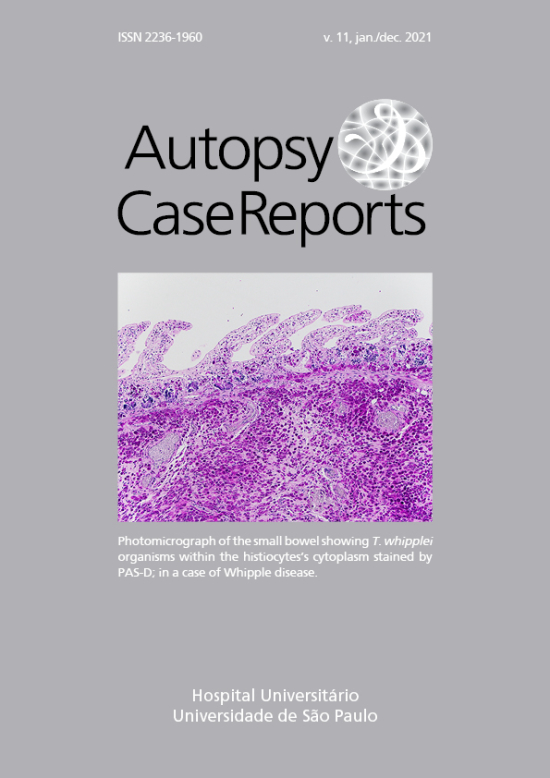Photobiomodulation in the treatment of xerostomia associated with hyposalivation in a pediatric patient with systemic scleroderma
DOI:
https://doi.org/10.4322/acr.2020.220Keywords:
scleroderma, systemic, low-level light therapy, pediatrics, laser therapy, xerostomiaAbstract
Scleroderma is a rare autoimmune disease characterized by excessive collagen production. The oral manifestations of the patient with scleroderma can include microstomia, xerostomia, and changes in the resorption teeth. We report the case of a 7-year-old female patient diagnosed with systemic scleroderma where photobiomodulation therapy was used to treat xerostomia associated with hyposalivation. She attended a pediatric clinic and presented with dry and rigid facial skin, trismus, xerostomia, malocclusion, and difficulty swallowing. Stimulated salivary flow was assessed before, during, and after treatment. Photobiomodulation therapy was conducted at four points at the sublingual glands with 660 nm, 100 mW, and 0.8 J/cm2 to each point; eight points at the parotid glands; and six points at the submandibular glands with 808 nm, 100 mW, and 0.8 J/cm2 for 8 seconds at each point. After this therapy, an increase in salivary flow, remission of the xerostomia, and an improvement in mastication and swallowing were observed. Photobiomodulation therapy was effective in controlling xerostomia in this pediatric patient, resulting in increased salivary flow and an improvement in her quality of life.
Downloads
References
Fett N. Scleroderma: nomenclature, etiology, pathogenesis, prognosis, and treatments: facts and controversies. Clin Dermatol. 2013;31(4):432-7. http://dx.doi.org/10.1016/j.clindermatol.2013.01.010. PMid:23806160.
LeRoy EC, Black C, Fleischmajer R, et al. Scleroderma (systemic sclerosis): classification, subsets and pathogenesis. J Rheumatol. 1988;15(2):202-5. PMid:3361530.
Katsambas A, Stefanaki C. Life-threatening dermatoses due to connective tissue disorders. Clin Dermatol. 2005;23(3):238-48. http://dx.doi.org/10.1016/j.clindermatol.2004.06.004. PMid:15896538.
Herrick AL, Ennis H, Bhushan M, Silman AJ, Baildam EM. Incidence of childhood linear scleroderma and systemic sclerosis in the UK and Ireland. Arthritis Care Res. 2010;62(2):213-8. http://dx.doi.org/10.1002/acr.20070. PMid:20191520.
Smirani R, Truchetet ME, Poursac N, Naveau A, Schaeverbeke T, Devillard R. Impact of systemic sclerosis oral manifestations on patients’ health-related quality of life: a systematic review. J Oral Pathol Med. 2018;47(9):808-15. http://dx.doi.org/10.1111/jop.12739. PMid:29855076.
Dixit S, Kalkur C, Sattur AP, Bornstein MM, Melton F. Scleroderma and dentistry: two case reports. J Med Case Rep. 2016;10(1):297. http://dx.doi.org/10.1186/s13256-016-1086-1. PMid:27776552.
Sreebny LM. Saliva in health and disease: an appraisal and update. Int Dent J. 2000;50(3):140-61. http://dx.doi.org/10.1111/j.1875-595X.2000.tb00554.x. PMid:10967766.
Navazesh M. Methods for collecting saliva. Ann N Y Acad Sci. 1993;694(1):72-7. http://dx.doi.org/10.1111/j.1749-6632.1993.tb18343.x. PMid:8215087.
Fidelix T, Czapkowski A, Azjen S, Andriolo A, Neto PH, Trevisani V. Low-level laser therapy for xerostomia in primary Sjögren’s syndrome: a randomized trial. Clin Rheumatol. 2018;37(3):729-36. http://dx.doi.org/10.1007/s10067-017-3898-9. PMid:29119483.
Biswas R, Ahn JC, Moon JH, et al. Low-level laser therapy with 850 nm recovers salivary function via membrane redistribution of aquaporin 5 by reducing intracellular Ca(2+) overload and ER stress during hyperglycemia. Biochim Biophys Acta Gen Subj. 2018;1862(8):1770-80. http://dx.doi.org/10.1016/j.bbagen.2018.05.008. PMid:29751100.
Lončar B, Stipetić MM, Baričević M, Risović D. The effect of low-level laser therapy on salivary glands in patients with xerostomia. Photomed Laser Surg. 2011;29(3):171-5. http://dx.doi.org/10.1089/pho.2010.2792. PMid:21054200.
Brzak BL, Cigić L, Baričević M, Sabol I, Mravak-Stipetić M, Risović D. different protocols of photobiomodulation therapy of hyposalivation. Photomed Laser Surg. 2018;36(2):78-82. http://dx.doi.org/10.1089/pho.2017.4325. PMid:29022754.
Millsop JW, Wang EA, Fazel N. Etiology, evaluation, and management of xerostomia. Clin Dermatol. 2017;35(5):468-76. http://dx.doi.org/10.1016/j.clindermatol.2017.06.010. PMid:28916028.
Crincoli V, Fatone L, Fanelli M, et al. Orofacial manifestations and temporomandibular disorders of systemic scleroderma: an observational study. Int J Mol Sci. 2016;17(7):E1189. http://dx.doi.org/10.3390/ijms17071189. PMid:27455250.
Steen VD, Medsger TA. Changes in causes of death in systemic sclerosis, 1972-2002. Ann Rheum Dis. 2007;66(7):940-4. http://dx.doi.org/10.1136/ard.2006.066068. PMid:17329309.
Lima DP, Diniz DG, Moimaz SA, Sumida DH, Okamoto AC. Saliva: reflection of the body. Int J Infect Dis. 2010;14(3):e184-8. http://dx.doi.org/10.1016/j.ijid.2009.04.022. PMid:19726214.
Downloads
Published
Issue
Section
License
Copyright (c) 2021 Autopsy and Case Reports

This work is licensed under a Creative Commons Attribution 4.0 International License.
Copyright
Authors of articles published by Autopsy and Case Report retain the copyright of their work without restrictions, licensing it under the Creative Commons Attribution License - CC-BY, which allows articles to be re-used and re-distributed without restriction, as long as the original work is correctly cited.



